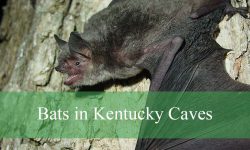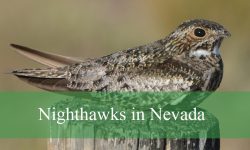Texas hosts a remarkable variety of owl species, from the powerful Great Horned Owl to the tiny Elf Owl. These nocturnal birds live in diverse habitats including forests, deserts, grasslands, and even suburban neighborhoods, making them a captivating subject for birdwatchers.
Each owl species has unique features, calls, and hunting behaviors that help with identification in the wild. Exploring East Texas’s dense woodlands or the arid Rio Grande Valley offers many opportunities to encounter these fascinating creatures. This guide covers 14 species of owls found in Texas, complete with pictures and identification tips.
Common Owls in Texas You Can See
Great Horned Owl (Bubo virginianus)
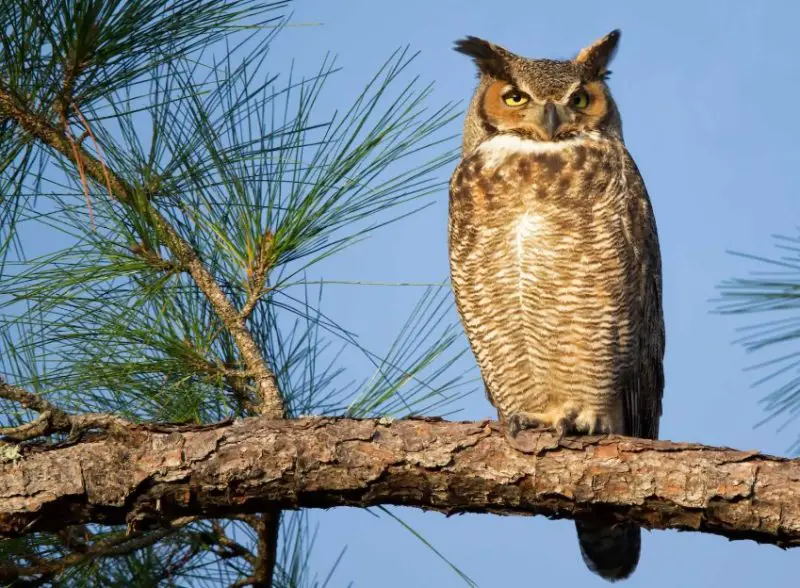
The Great Horned Owl is one of the most iconic raptors in Texas, easily recognized by its large size and distinctive feathered tufts resembling “horns.” Adults typically range from 18 to 25 inches in length with a wingspan of about 3.3 to 4.8 feet, making them one of the largest owls in North America. Their plumage is mottled gray-brown with a white throat patch, providing excellent camouflage among trees. Bright yellow eyes and a powerful hooked beak add to their fierce appearance.
Their call is a deep, resonant series of “hoo-hoo-hoo-hoo” sounds, often described as the classic owl hoot. In Texas, their hoots echo through forests, open fields, and even suburban neighborhoods, particularly during the breeding season from January to February. They are primarily nocturnal and rely on their incredible low-light vision and acute hearing to locate prey.
Great Horned Owls are apex predators, feeding on a wide variety of animals including rabbits, skunks, snakes, and even other birds of prey. They use their powerful talons, capable of exerting around 300 pounds of pressure per square inch, to crush and kill prey quickly. Unlike many owls, they are not picky eaters and can adapt to the available food sources in different habitats.
Fun fact: Great Horned Owls are sometimes called the “tiger of the sky” due to their aggressive hunting style. They are also one of the few predators in Texas that regularly hunt skunks, being immune to their foul spray.
Barn Owl (Tyto furcata)
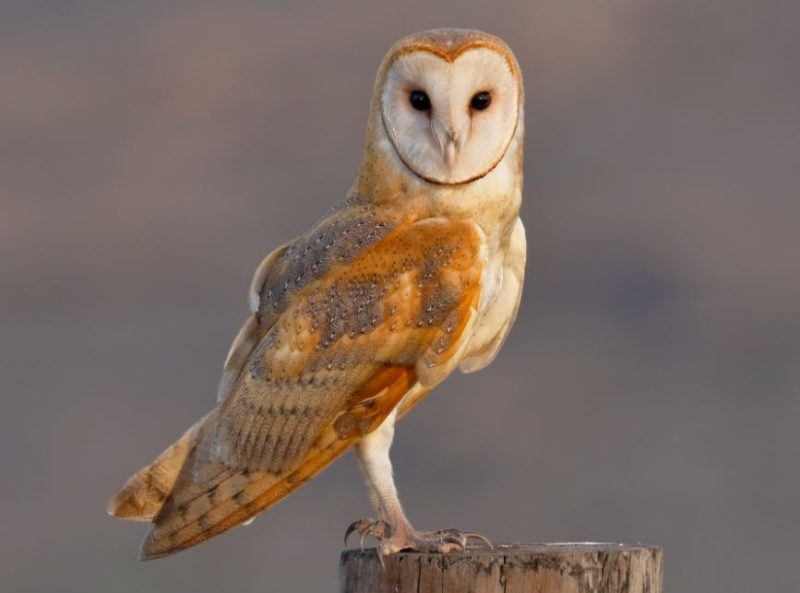
The Barn Owl, also known as the American Barn Owl, is a medium-sized owl with a distinct heart-shaped facial disc that is pale white to light tan. Adults measure around 12 to 15 inches long with a wingspan of 3 to 3.5 feet. Their underparts are typically white or buff, while the upperparts show a mix of gray and golden-brown speckled with dark spots, giving them a ghostly appearance when flying at night.
This owl is famous for its eerie, screeching call, which sounds more like a harsh hiss or scream rather than the hoots of other owls. In Texas, their cries are commonly heard around farmlands, grasslands, and open fields, where they thrive. Barn Owls prefer to nest in hollow trees, barns, or other man-made structures, which is how they earned their name.
Barn Owls are specialized rodent hunters, feeding primarily on mice, rats, and voles. They have excellent low-light vision, but their real hunting advantage lies in their asymmetrical ears, which allow them to pinpoint prey in complete darkness. A single Barn Owl family can consume thousands of rodents in a year, making them valuable natural pest controllers in Texas farms.
Fun fact: Barn Owls swallow their prey whole and later regurgitate pellets of bones and fur. Farmers in Texas often encourage Barn Owls to nest nearby by installing owl boxes to naturally control rodent populations.
Eastern Screech-Owl (Megascops asio)
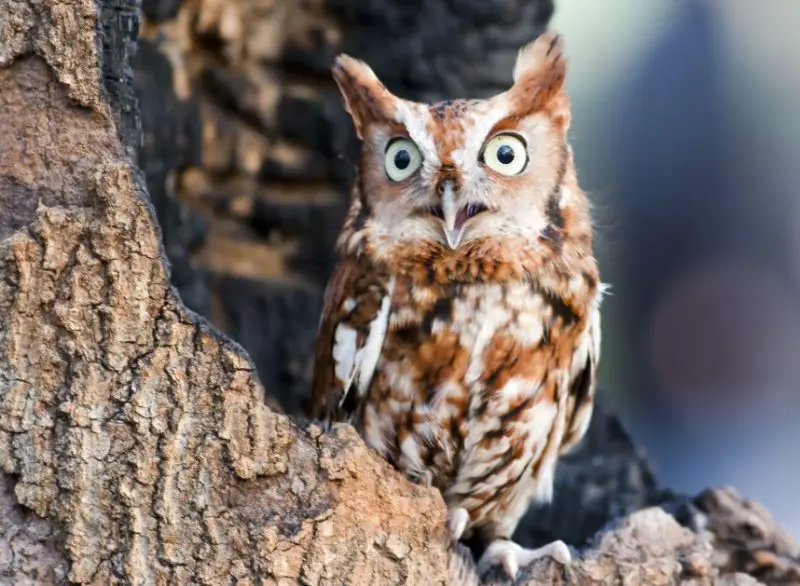
The Eastern Screech-Owl is a small yet highly adaptable owl found throughout Texas, especially in the eastern and central regions. Adults measure around 6 to 10 inches long with a wingspan of 18 to 24 inches. They come in two color morphs—gray and reddish-brown—both providing excellent camouflage against tree bark. Their yellow eyes and small ear tufts give them a stern expression.
Despite their name, Eastern Screech-Owls don’t truly screech. Instead, they produce a series of soft trills or descending whinnies, which can sound almost horse-like. In Texas, their calls are most noticeable in wooded areas, parks, and suburban backyards, especially during spring and summer nights. These owls are cavity nesters and frequently use abandoned woodpecker holes or man-made nest boxes.
Their diet consists of insects, small mammals, reptiles, and occasionally small birds. Eastern Screech-Owls are ambush hunters, waiting motionlessly before swooping silently to capture prey with their sharp talons. They often store excess food in tree cavities for later consumption, a behavior not commonly observed in other owl species.
Fun fact: Eastern Screech-Owls are masters of camouflage and will freeze against a tree trunk when threatened, blending so well with bark that they almost disappear. Many Texans never realize an owl is watching them from just a few feet away.
Western Screech-Owl (Megascops kennicottii)
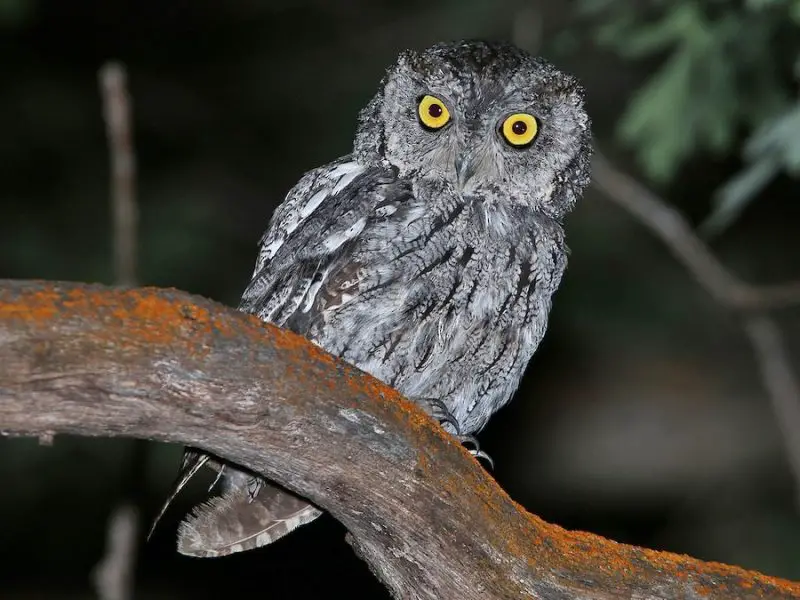
The Western Screech-Owl is slightly larger than its eastern relative, measuring about 7 to 10 inches long with a wingspan of 20 to 24 inches. It has a mottled gray or brown plumage with faint streaking, blending perfectly with tree bark. Its piercing yellow eyes and small ear tufts help in identifying it, although it can be easily confused with the Eastern Screech-Owl where their ranges overlap.
Their call is a series of short, evenly pitched hoots that accelerate into a bouncing ball-like rhythm, very different from the trills of Eastern Screech-Owls. In Texas, they are mainly found in the western and southern regions, inhabiting deserts, canyons, and mesquite woodlands. They prefer tree cavities, saguaro cacti, or cliff crevices for nesting.
Western Screech-Owls are opportunistic hunters, feeding on insects, small mammals, reptiles, and occasionally fish or amphibians. They are agile flyers and often hunt close to the ground, swooping silently to grab prey. Unlike some owls, they are tolerant of dry, arid conditions, making them well-suited for the Texas desert regions.
Fun fact: Western Screech-Owls have been observed caching food for later, sometimes stuffing prey into tree cavities. Some even use abandoned woodpecker nests, making them important secondary cavity users in Texas ecosystems.
Barred Owl (Strix varia)
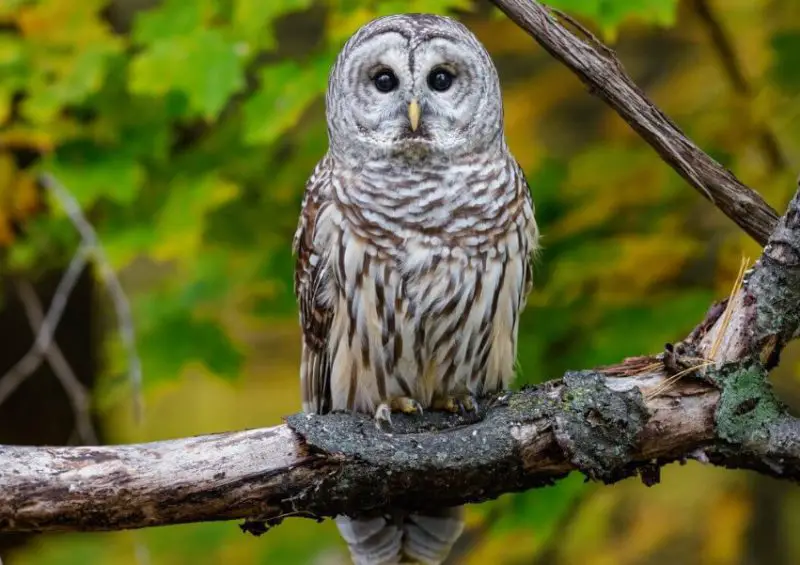
The Barred Owl is a large, stocky owl measuring 16 to 25 inches in length with a wingspan of 3.5 to 4 feet. It has a rounded head with no ear tufts, dark brown eyes, and distinctive horizontal barring on the chest with vertical streaks on the belly. Its rich brown and white plumage provides effective camouflage in dense woodlands.
Their call is a series of loud hoots described as “Who cooks for you? Who cooks for you all?” In Texas, these calls echo through forests and swampy regions, especially in the eastern part of the state. They prefer mature forests near water sources, such as cypress swamps or riverbanks, where they roost and nest in tree cavities.
Barred Owls feed on a variety of prey, including rodents, rabbits, frogs, and even crayfish. They are patient hunters, often waiting silently on a perch before swooping down to capture prey. Unlike many owls, Barred Owls are more likely to hunt during twilight or even daytime, especially in overcast weather.
Fun fact: Barred Owls are known to mate for life and often return to the same nesting sites year after year. In some areas of Texas, they compete with Great Horned Owls, which are known to prey on them if given the chance.
Spotted Owl (Strix occidentalis lucida)
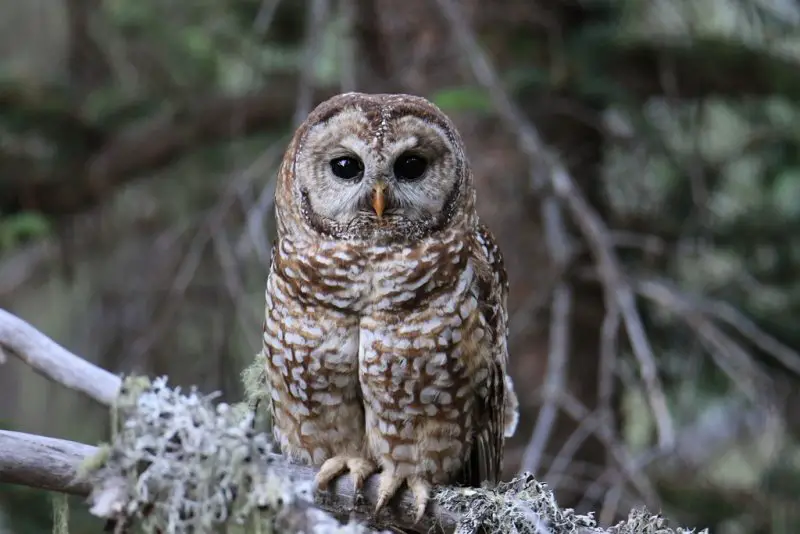
The Mexican Spotted Owl, a subspecies of the Spotted Owl, is a medium-to-large owl measuring about 17 to 19 inches long with a wingspan of approximately 3.5 feet. It has a rounded head with no ear tufts, dark brown eyes, and brown plumage heavily speckled with white spots, which gives it its name. Its facial disc is pale and framed by dark brown feathers, helping birdwatchers identify it more easily in Texas mountain regions.
The call of the Spotted Owl is a series of deep, resonant hoots given in a four-note pattern. In Texas, they are mostly found in remote mountainous regions such as the Guadalupe and Davis Mountains, where their calls echo through dense canyons. These owls prefer old-growth coniferous and mixed woodlands, nesting in tree cavities or cliff ledges where they are less likely to be disturbed.
Spotted Owls feed primarily on small mammals like woodrats and mice, but they will also consume birds, insects, and occasionally reptiles. They are ambush hunters, perching silently before swooping on prey. Unlike some other owls, they hunt mostly at dusk and dawn, taking advantage of low-light conditions in dense forests.
Fun fact: The Mexican Spotted Owl is a federally threatened species due to habitat loss, making every sighting in Texas a special event for birdwatchers. Their preference for undisturbed old-growth forests makes them an important indicator species for forest ecosystem health.
Flammulated Owl (Psiloscops flammeolus)
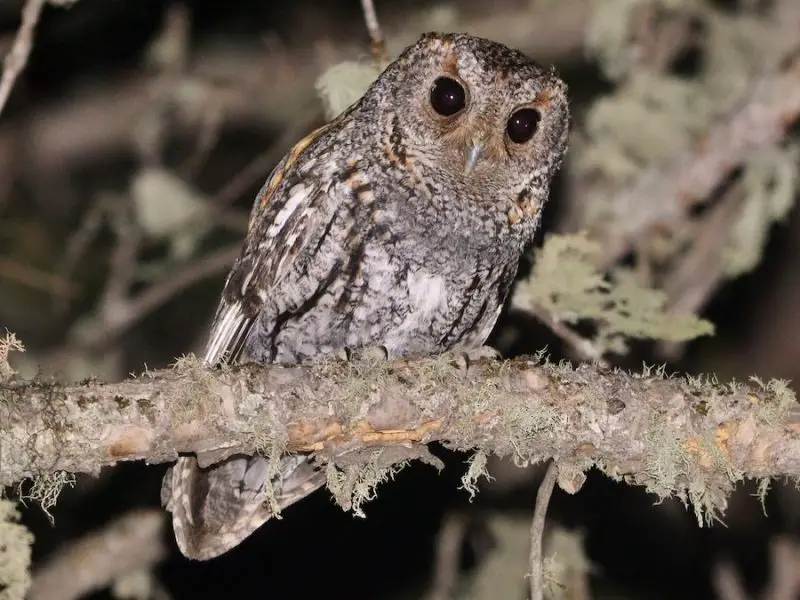
The Flammulated Owl is one of the smallest owls in Texas, measuring only 5.5 to 6.7 inches in length with a wingspan of about 14 inches. It has a gray-brown mottled plumage with rust-colored markings and dark vertical streaks, giving it a “flame-like” appearance, which inspired its name. Its dark eyes set it apart from many other small owls, which typically have yellow eyes.
This owl has a soft, low-pitched hoot that sounds more like a dove than a typical owl. In Texas, its call can occasionally be heard in mountainous coniferous forests, especially during summer when it migrates south from breeding areas. It prefers open pine and fir woodlands, roosting high in trees during the day.
Flammulated Owls are primarily insectivorous, feeding almost exclusively on moths, beetles, and other flying insects. They catch prey mid-flight, making them highly agile hunters. Unlike most owls, they rarely eat rodents, which explains their smaller size and lightweight body structure.
Fun fact: Flammulated Owls are long-distance migrants, traveling from Texas to Central America during winter. Their excellent camouflage and nocturnal habits make them very hard to spot, even for experienced birders.
Ferruginous Pygmy-Owl (Glaucidium brasilianum)
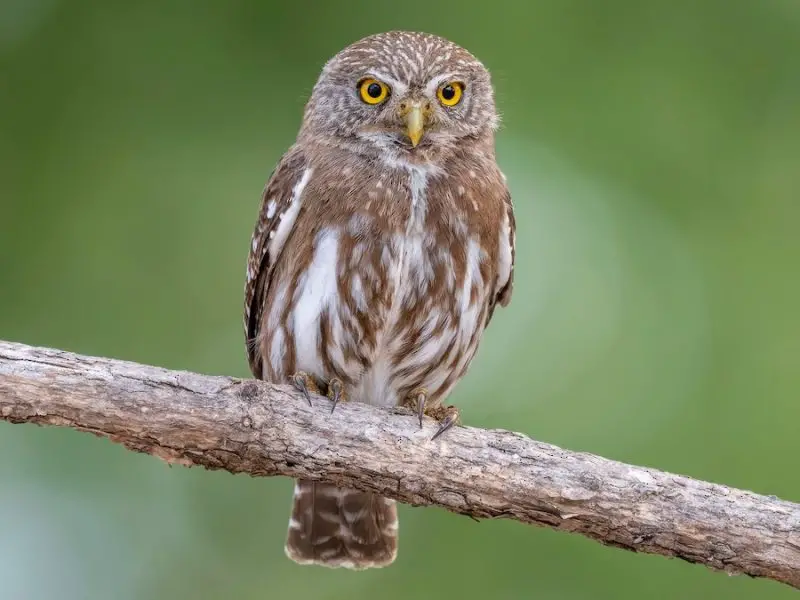
The Ferruginous Pygmy-Owl is a small but fierce predator, measuring about 6.5 to 7 inches in length with a wingspan of 14 to 16 inches. Its upperparts are rufous-brown with fine white streaks, and its underparts are pale with reddish-brown barring. A notable feature is the pair of dark “eye spots” on the back of its head, which help deter potential predators.
Unlike many owls, this species is active during the day, making its high-pitched, repetitive “toot-toot-toot” call easier to hear. In Texas, Ferruginous Pygmy-Owls are found mainly in the southernmost regions, including the Rio Grande Valley, where they inhabit thorn scrub, mesquite woodlands, and riparian forests.
These owls are aggressive hunters, preying on insects, lizards, small mammals, and even birds larger than themselves. They are known for their boldness, often taking prey almost their own size. Because they hunt during daylight, they are more frequently observed than most nocturnal owl species.
Fun fact: The Ferruginous Pygmy-Owl is so fearless that small songbirds often mob it to drive it away. Birders sometimes locate these owls by listening for groups of agitated songbirds making alarm calls.
Elf Owl (Micrathene whitneyi)
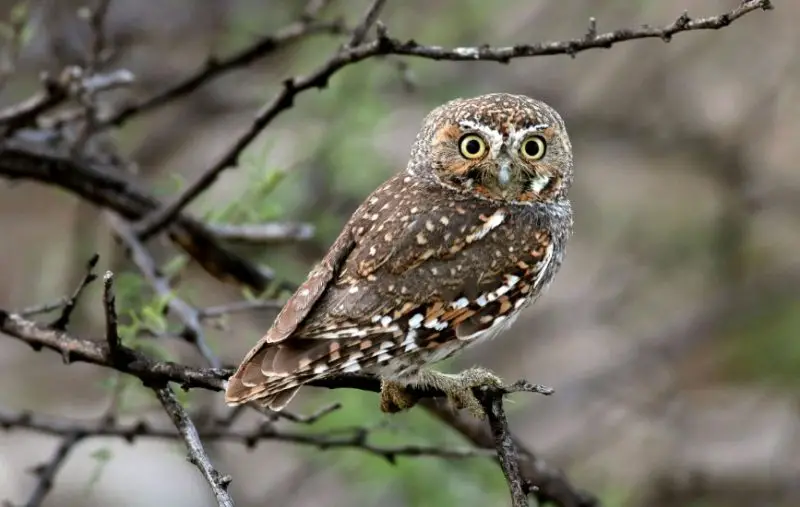
The Elf Owl holds the title of the smallest owl in the world, measuring only 5 to 5.7 inches in length with a wingspan of about 9 to 10 inches. Its tiny size, round head without ear tufts, and dull brown-gray plumage help it blend seamlessly with tree bark. Its pale facial disc and bright yellow eyes give it an alert expression.
Elf Owls produce a high-pitched, chattering series of yelps, sounding almost like tiny barks. In Texas, they are mainly found in the desert regions of West and South Texas, especially in saguaro cacti, mesquite, and oak woodlands. They are cavity nesters, frequently using old woodpecker holes or natural hollows in trees and cacti.
This owl feeds primarily on insects and other invertebrates, catching moths, beetles, and spiders during night flights. Occasionally, it will eat small reptiles and amphibians. Elf Owls are strictly nocturnal and are more active during warm summer nights when insects are abundant.
Fun fact: Despite their tiny size, Elf Owls migrate long distances, spending winters in Mexico. Their name perfectly suits them—they truly resemble little “forest elves” darting among branches.
Northern Saw-whet Owl (Aegolius acadicus)
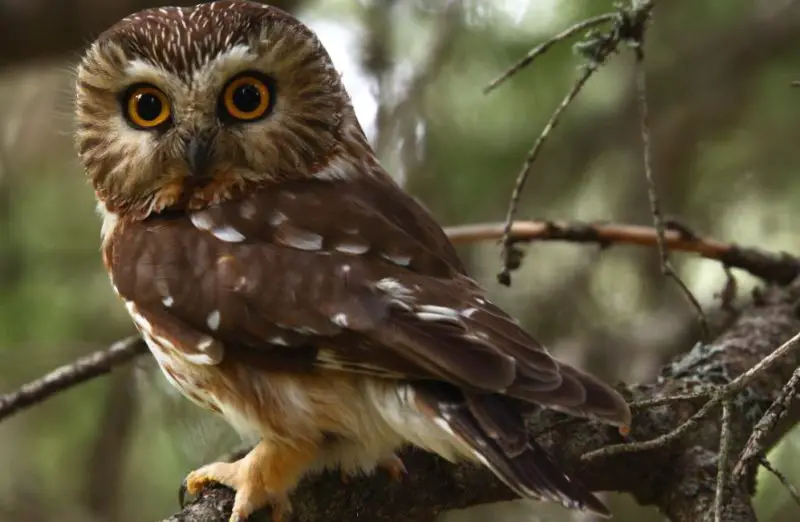
The Northern Saw-whet Owl is a small, stocky owl measuring about 7 to 8.5 inches long with a wingspan of 16 to 19 inches. It has a rounded head with no ear tufts, a white facial disc edged with brown, and bright yellow eyes. Its brown plumage with white streaks helps it blend in with tree bark during the day.
Its call is a repetitive “too-too-too” whistle, resembling the sound of a saw being sharpened, which inspired its name. In Texas, this owl is rare and mostly seen during winter migration in wooded regions, particularly in the Panhandle and northern areas. It prefers dense coniferous or mixed forests, roosting quietly in thick foliage during the day.
Northern Saw-whet Owls feed mainly on small rodents, especially deer mice, but will also eat insects and small birds. They are stealthy nocturnal hunters, using their sharp hearing and silent flight to capture prey. These owls are known to decapitate prey before eating, often storing leftovers in tree branches for later.
Fun fact: Because of their small size and secretive habits, Northern Saw-whet Owls are often discovered only when accidentally flushed from their roosts by birders or hikers. They are considered one of the cutest owls due to their big, round eyes and tiny body.
Long-eared Owl (Asio otus)
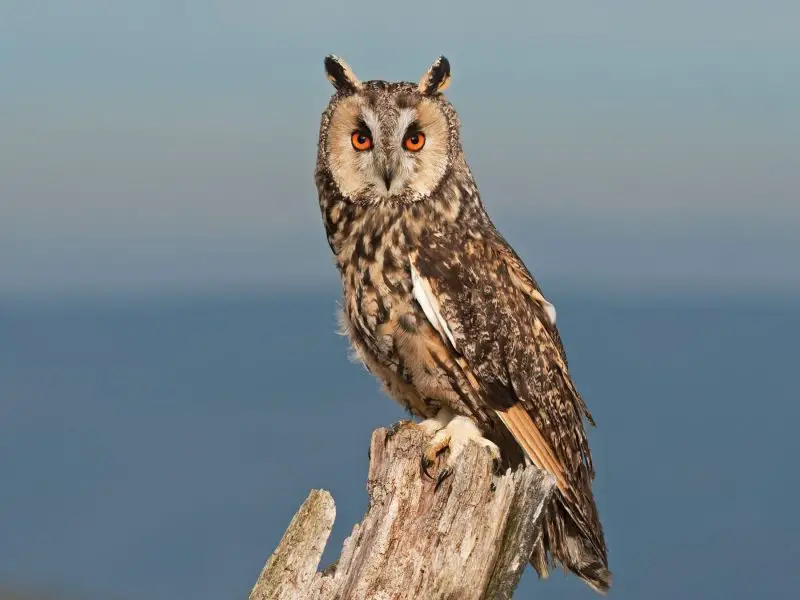
The Long-eared Owl is a medium-sized owl measuring about 13 to 16 inches in length with a wingspan of 35 to 40 inches. Its most distinctive features are its tall, erect ear tufts and mottled brown and buff plumage, which provides excellent camouflage among tree branches. Its orange facial disc, bright yellow eyes, and slender body make it one of the easiest owls to recognize in Texas during winter.
Its call is a series of low, deep hoots repeated at intervals, but it is more often detected by its raspy barks or high-pitched squeals during the breeding season. In Texas, Long-eared Owls are mostly winter visitors, found in dense woodlands, riparian forests, and areas with thick shrubs where they roost in groups during the day. At night, they move to open fields and grasslands to hunt.
Long-eared Owls feed mainly on small mammals, particularly mice and voles, though they also take small birds when available. They hunt by perching quietly and then gliding silently toward their prey. Their long wings and light body make them agile, allowing them to maneuver quickly in pursuit of prey.
Fun fact: Long-eared Owls often roost communally in winter, with multiple birds sharing the same tree. This behavior makes them easier to spot in Texas during colder months, especially in thick cedar or pine groves.
Short-eared Owl (Asio flammeus)
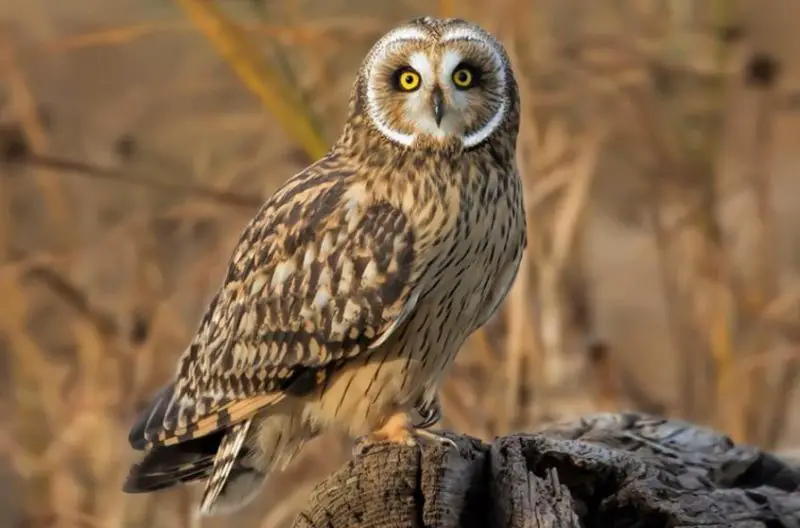
The Short-eared Owl is a medium-sized owl measuring about 13 to 17 inches long with a wingspan of 33 to 40 inches. Unlike its long-eared relative, its ear tufts are almost invisible, giving it a round-headed appearance. Its plumage is mottled brown and buff with pale underparts streaked with dark brown, helping it blend with grasslands.
Its call is rarely heard, but it sometimes makes raspy barks or soft squeaks. In Texas, Short-eared Owls are most commonly seen during winter, particularly in open grasslands, marshes, and prairies. Unlike most owls, they are active during the day, especially at dawn and dusk, flying low over fields in search of prey.
These owls primarily hunt small mammals like voles, mice, and shrews, occasionally taking small birds. They are fast and powerful fliers, often gliding with their wings held in a characteristic V-shape while scanning the ground for movement.
Fun fact: Short-eared Owls are one of the most widely distributed owls in the world, found on every continent except Australia and Antarctica. In Texas, their day-flying habit makes them one of the easiest owls to spot in open country.
Northern Pygmy Owl (Glaucidium californicum)
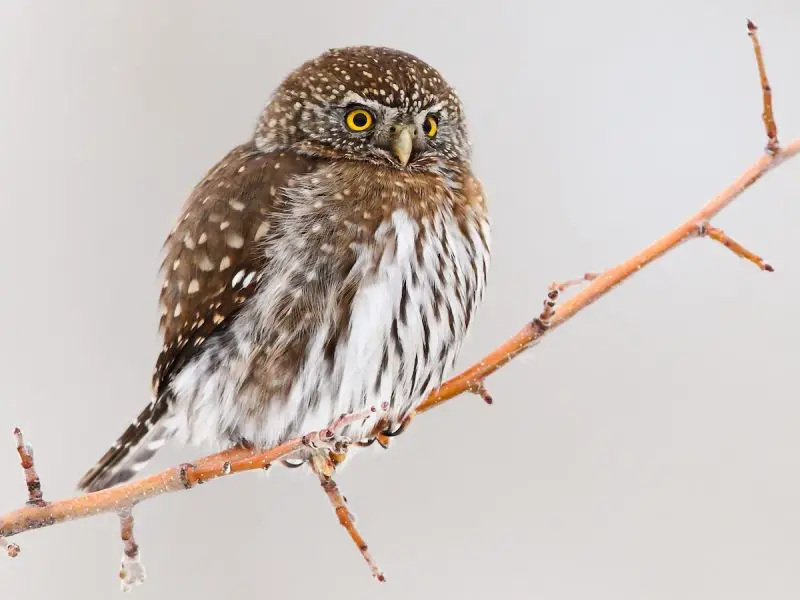
The Northern Pygmy Owl is a tiny but bold predator, measuring about 6 to 7 inches in length with a wingspan of 12 inches. Its brown plumage with white spots, yellow eyes, and long tail make it distinctive. Like the Ferruginous Pygmy-Owl, it has dark “eye spots” on the back of its head, which help confuse predators.
Its call is a series of high-pitched, evenly spaced whistles. In Texas, this species is extremely rare, occasionally recorded in the far western mountains. It inhabits coniferous and mixed forests, preferring areas with dense cover and open hunting grounds.
Despite its small size, the Northern Pygmy Owl hunts aggressively during the day, preying on small birds, rodents, and insects. It often captures birds nearly its own size, demonstrating remarkable strength for such a tiny raptor.
Fun fact: Northern Pygmy Owls are known to decapitate their bird prey and store the remains in tree branches for later feeding. Songbirds often mob this owl aggressively, giving away its location to birdwatchers.
Whiskered Screech-Owl (Megascops trichopsis)
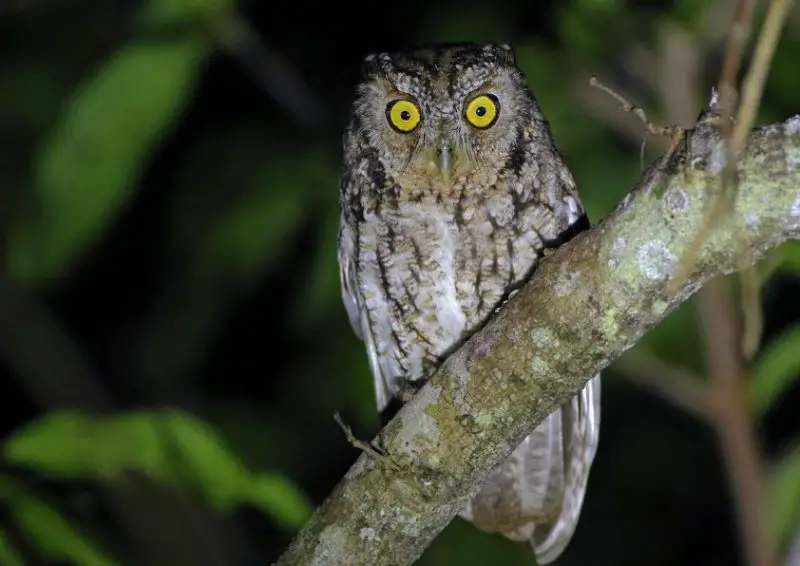
The Whiskered Screech-Owl is a small owl measuring about 6.5 to 7.5 inches in length with a wingspan of 18 inches. It has gray-brown plumage with fine streaks and a pale facial disc framed by faint “whisker-like” feathers, which give the species its name. Its bright yellow eyes and small ear tufts make it look very similar to other screech-owls.
Its call is a series of soft, rhythmic hoots or trills. In Texas, this owl is considered an accidental or rare visitor, occasionally appearing in the extreme southern regions near the Mexican border. It inhabits dense oak and pine-oak forests, preferring areas with thick canopy cover.
Whiskered Screech-Owls feed mainly on insects and other invertebrates, occasionally taking small mammals or reptiles. They hunt at night, using their silent flight and excellent night vision to ambush prey. Like other screech-owls, they are cavity nesters, using old woodpecker holes or natural hollows.
Fun fact: The Whiskered Screech-Owl is more common in Mexico and Central America, making any sighting in Texas a rare treat for birders. Its soft calls are often mistaken for insects, making it easy to overlook.
FAQs About Owls in Texas
What is the most common owl in Texas?
The Great Horned Owl is the most common owl in Texas, found throughout forests, grasslands, deserts, and even urban areas. Its adaptability to different habitats and varied diet makes it the most widespread species in the state.
Which owl is the smallest in Texas?
The Elf Owl (Micrathene whitneyi) holds the title of the smallest owl in Texas, measuring only about 5 to 5.7 inches in length. Despite its tiny size, it is a skilled hunter, feeding mainly on insects.
Are there owls active during the day in Texas?
Yes, a few species such as the Ferruginous Pygmy-Owl and Short-eared Owl are active during the day. The Ferruginous Pygmy-Owl hunts mostly in the morning and late afternoon, while the Short-eared Owl is often seen gliding over open fields at dusk.
What is the rarest owl in Texas?
The Whiskered Screech-Owl is one of the rarest owls in Texas, occasionally seen near the Mexican border. The Northern Pygmy Owl and Flammulated Owl are also considered rare visitors, mostly found in remote mountain regions.
Can you hear owls hooting in Texas cities?
Yes, species like the Great Horned Owl, Barn Owl, and Eastern Screech-Owl can be heard in suburban and even urban areas, especially where there are large trees, parks, or open fields.
Do owls in Texas migrate?
Some owls in Texas, like the Flammulated Owl and Northern Saw-whet Owl, are migratory and only appear seasonally. However, many species, including the Great Horned Owl and Eastern Screech-Owl, are year-round residents.
Where is the best place to see owls in Texas?
Owls can be seen across Texas, but specific hotspots include Big Bend National Park for Elf Owls, the Rio Grande Valley for Ferruginous Pygmy-Owls, and forested regions in East Texas for Barred and Eastern Screech-Owls.


